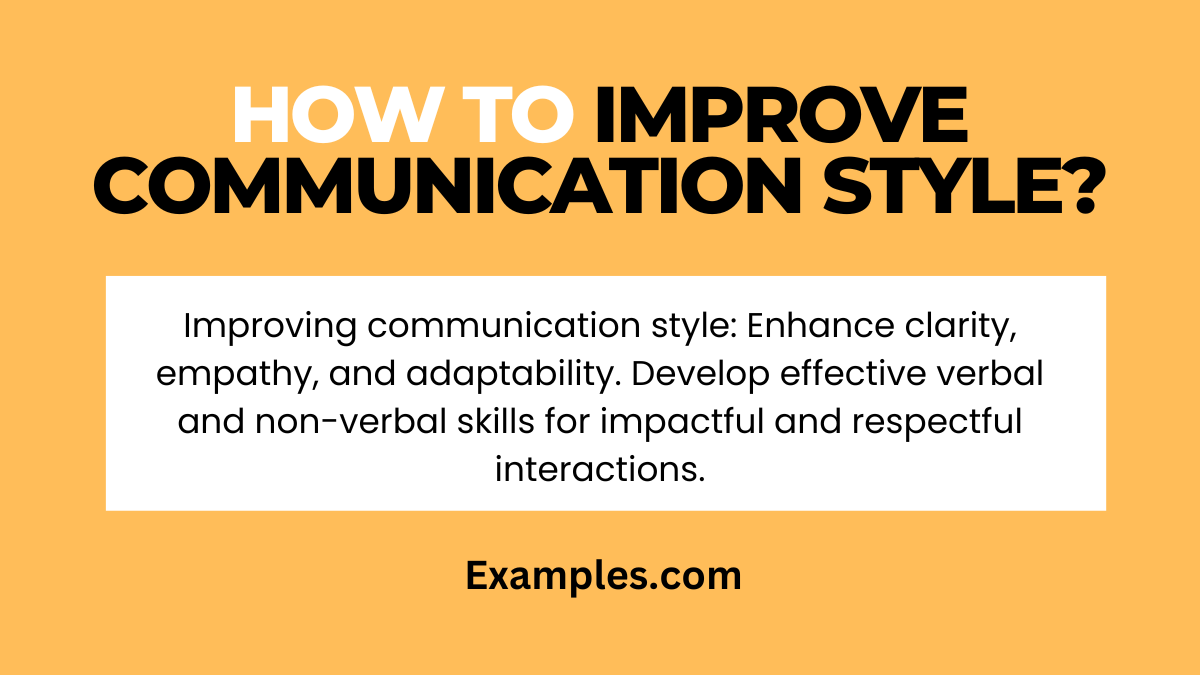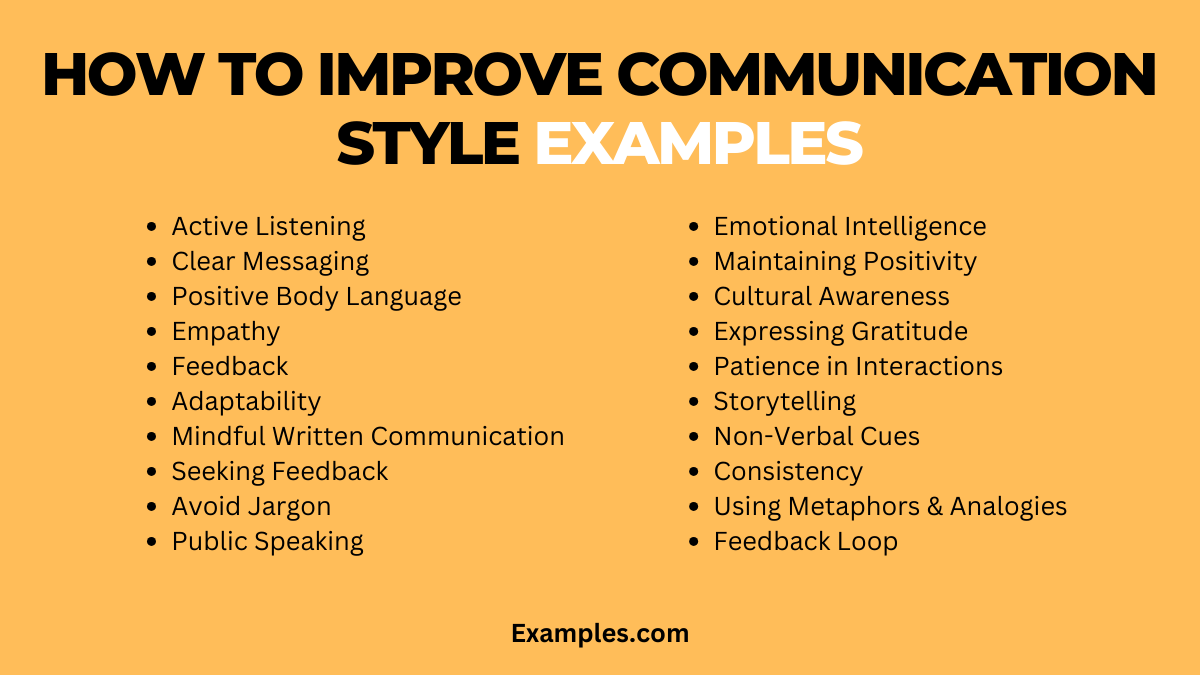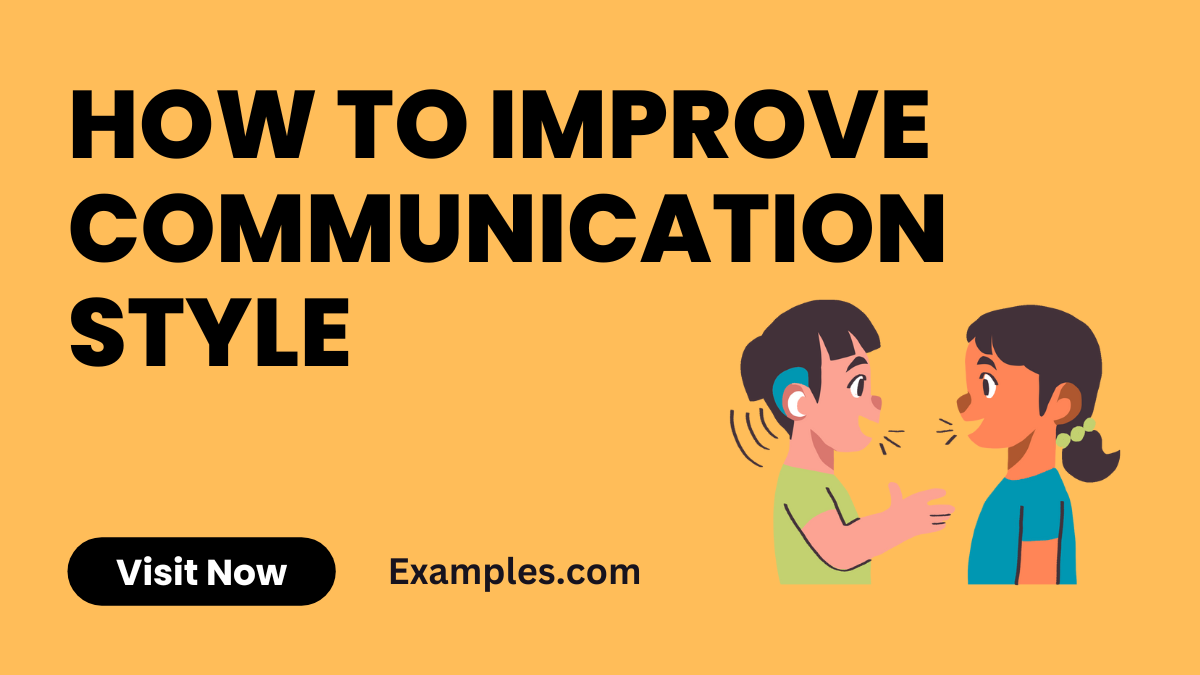How to Improve Communication Style – 19+ Examples
Embark on a journey to enhance your communication with our comprehensive guide. Discover strategies, Communication Examples, and insightful tips tailored to elevate your interaction skills. With practical examples and expert advice, you’ll learn to articulate your thoughts more effectively and build stronger connections in every aspect of your life.
How to Improve Communication Style?

Improving your communication style means developing the way you interact with others to become more clear, effective, and empathetic. It involves enhancing verbal and non-verbal skills, adapting to different situations, and understanding others’ perspectives to foster better exchanges. It’s about making your communication more impactful, respectful, and responsive to the needs of various conversations, whether personal or professional.
20 How to Improve Communication Style Examples

Enhance your communication prowess with this concise guide, featuring strategies infused with keywords to address various Communication Styles Examples and scenarios. From personal connections to professional settings, these tactics will guide you in refining your approach, whether it’s adopting an Assertive Communication Style in leadership or fostering an Open Communication Style in relationships. Embrace these tips to master the Types of Communication Styles and navigate the nuances of Communication Styles in the Workplace and beyond.
- Active Listening: Embrace this technique across all communication styles, ensuring you fully engage in every conversation.
- Clear Messaging: Adopt a Reflective Communication Style to convey your thoughts succinctly and clearly.
- Positive Body Language: Use open gestures and eye contact to complement your Assertive Communication Style.
- Empathy: Essential in Communication Styles in Relationships, show understanding and consideration for others’ perspectives.
- Feedback: Offer constructive criticism in a balanced manner, reflecting a Casual Communication Style when appropriate.
- Adaptability: Modify your approach to suit various contexts, whether in Leadership or team collaborations.
- Mindful Written Communication: Ensure emails reflect the desired tone, especially important in formal Communication Styles in the Workplace.
- Seeking Feedback: Regularly ask for input to continuously refine your Personal Communication Style.
- Avoid Jargon: Speak plainly, particularly when employing an Aggressive Communication Style needs softening.
- Public Speaking: Enhance your ability to engage and inform any audience, striving for what is often considered the Most Desirable Style of Communication.
- Emotional Intelligence: A key component in effectively managing both Passive and Aggressive Communication Styles.
- Maintaining Positivity: Crucial in maintaining a Passive-Aggressive Communication Style at bay and fostering a positive environment.
- Cultural Awareness: Understand and respect differences, a must in global Communication Styles in the Workplace.
- Expressing Gratitude: An often overlooked yet powerful aspect of Manipulative Communication Style, when used positively.
- Patience in Interactions: Particularly important when dealing with a Passive Communication Style or in conflict resolution.
- Storytelling: Utilize this approach to bring life to Communication Styles Examples in training or presentations.
- Non-Verbal Cues: Integral to all types of communication, from Aggressive to Casual Communication Styles.
- Consistency: Ensure your message remains consistent, a hallmark of an effective and Desirable Style of Communication.
- Using Metaphors & Analogies: Enhance understanding and engagement, particularly effective in Reflective Communication Style, making complex ideas more relatable.
- Feedback Loop: Establish a continuous feedback mechanism, vital in evolving and improving your Communication Style in various settings, from personal relationships to professional environments.
How to Improve Communication Style in a Relationship
Improving communication in relationships involves empathy, clarity, and active listening. Just as Communication Style for Leaders and Managers requires adaptability and awareness, so too does communication in personal relationships. By employing strategies similar to those used by Influencers and Students to engage their audience, couples can significantly enhance their communication.
- Active Listening: “When you speak, I will give you my full attention and respond thoughtfully.” Actively listen to your partner without interrupting, showing genuine interest in their words.
- Expressing Needs Clearly: “I feel valued when we spend quality time together.” Clearly and respectfully express your needs and desires.
- Regular Check-Ins: “Let’s regularly discuss our feelings and experiences.” Establish routine conversations to share feelings and strengthen your bond.
- Empathy in Disagreements: “I understand your perspective, and here’s how I see it.” Show empathy during disagreements, seeking to understand before being understood.
- Appreciation and Positive Reinforcement: “I really appreciate it when you do…” Regularly express gratitude and appreciation, reinforcing positive aspects of your relationship.
How to Improve Communication Style for Students
Description: Enhancing communication style for students is crucial for academic success and personal growth. By mastering these techniques, students can improve their academic performance and build stronger relationships. In each of these examples, students learn to adapt their communication style to various academic contexts, laying a foundation for skills that are transferable to future environments like Communication Style for Work, Communication Style for Relationships, and beyond.
- Participating in Class Discussions: Speak clearly and stay on topic to contribute effectively in class. “During our discussion on Shakespeare, I believe that his use of imagery significantly enhances the narrative’s impact.”
- Group Project Collaboration: Use assertive yet respectful communication to share ideas and feedback in group settings. “I think if we divide the project into sections, we can work more efficiently and meet our deadline.”
- Presentations: Practice delivering presentations with a clear and engaging tone. “Today, I’ll be discussing the effects of climate change, focusing on its impact on global ecosystems.”
- Emailing Professors: Compose professional and concise emails when communicating with faculty. “Dear Professor Smith, I’m writing to inquire about the key themes for our upcoming essay assignment.”
- Peer-to-Peer Feedback: Provide constructive and supportive feedback to classmates. “Your essay was well-written. Perhaps adding more examples could further strengthen your argument.”
How to Improve Communication Style in Classroom
Improving communication style in the classroom involves recognizing diverse student communication styles and adapting your teaching approach accordingly. To excel in Communication Styles in the Classroom, strive to Modify Your Communication Style by being clear, engaging, and approachable. Understanding Student Style preferences can enhance classroom dynamics, foster effective learning, and create a more inclusive educational environment where students can thrive academically and socially.
What are the Important Communication Styles and How to Improve?
Understanding and improving upon important communication styles is essential for effective interaction in various aspects of life. This guide focuses on identifying key styles and providing strategic methods to enhance your communication ability, ensuring that your messages are delivered and received as intended, fostering better understanding and relationships. you can take targeted steps to improve your interactions and relationships effectively. Utilizing tools like communication style worksheets and assessments will provide a structured approach to developing a more effective and adaptable communication style.
- Assertive Style: This style is direct yet respectful. Improve by practicing stating your needs and opinions confidently while considering others’ viewpoints. Communication Style Worksheets can provide scenarios for practice.
- Passive Style: Often characterized by avoiding conflict and not expressing true feelings. To improve, work on expressing your thoughts openly and believe that your opinions are valuable.
- Aggressive Style: Typically involves dominating conversations and disregarding others. Improve by focusing on listening more, respecting others’ turns to speak, and expressing your views without belittling others.
- Passive-Aggressive Style: This indirect style expresses negative feelings subtly rather than openly. To improve, try to address issues directly and constructively, expressing dissatisfaction openly and respectfully.
- Open Style: Involves a willingness to share thoughts and feelings freely. Enhance this style by encouraging feedback from others and being receptive to it, which can be facilitated through regular Communication Style Assessment.
How can I Improve My Personal Communication Style?
To improve your personal communication style, practice active listening, engage in regular self-reflection, and seek feedback to understand your impact and areas for growth, essential in Communication Style with Management.
What are Skills to Develop in Communicating Style?
Developing clear articulation, effective listening, emotional intelligence, and adaptability are key skills in enhancing your communicating style, helping you navigate diverse scenarios and manage interactions more effectively.
In conclusion, improving your communication style is an ongoing journey that enhances personal and professional relationships. By understanding the effects, recognizing the signs, and applying targeted fixes, you can transform how you interact with others. Embrace the journey of continuous improvement to foster clearer, more effective, and empathetic communication, leading to stronger, more meaningful connections.



